Menu
Free Consultation
Infection and/or necrosis of the living tissue inside the tooth requires root canal treatment. The tissues that keep the tooth in the mouth are actually healthy gum and jawbone tissues, not the vascular and nerve bundle inside the tooth. Therefore, with a successful root canal treatment, it may be possible to keep the tooth in the mouth for many years. On the other hand, the critical role of endodontic preventive dentistry should not be overlooked, both in terms of treating infection and preventing other treatment needs that may arise due to extraction.
Micro endodontics, also known as microscopic endodontics, is an advanced and modern method of root canal treatment using a microscope. Micro endodontics is related to endodontics, a specialized branch of dentistry. Endodontics is a branch that treats the pulp, the soft tissue inside the teeth, and the roots of the teeth. Micro-endodontics is a method that allows these treatment methods to be applied in a more precise and detailed way.
Microendodontics refers to an approach that involves the use of a microscope. During endodontic procedures, microscopes are used to better visualize and treat the small canals inside the teeth. This method gives dentists a better view and allows procedures to be performed more precisely.
Microendodontics involves performing endodontic procedures such as pulp treatment, root canal treatment, apical resection under a microscope. In this way, more successful results are achieved and patient comfort is increased. Microendodontics is considered a significant advancement towards improving the quality of endodontic treatments with the use of technological advances in dentistry.
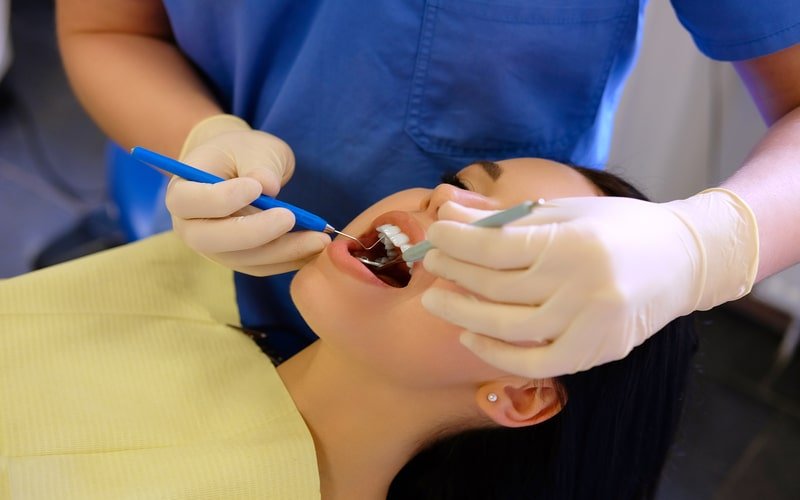
Microendodontics is a sub-branch of endodontics that enables treatments performed on the internal structure of the teeth to be performed more precisely and effectively, supported by microscopic imaging and specialized equipment. This innovative approach provides dentists with a clearer view and improves the treatment process. Thus, it may be possible to increase patient comfort and treatment success.
Microendodontics is performed in a similar way to traditional endodontic procedures. However, it is performed in a more detailed and precise manner with the use of microscopic imaging and specialized instruments. Microendodontic treatment begins with a patient examination and digital imaging techniques. The dentist diagnoses the problem by examining the internal structure of the tooth in detail.
Before the procedure begins, the dentist will administer an appropriate local anesthetic for the patient. A rubber palate is then placed around the tooth to keep the procedure area dry and provide a suitable environment for microendodontics.
Any decayed or damaged tissue on the tooth is removed. The dentist accesses the internal structure of the tooth using the microendodontic microscope. Then, the process of removing infected or damaged tissues in the pulp area begins.
Under the microendodontic microscope, the root canals are carefully enlarged and shaped. The next step is to fill the canals with special endodontic filling materials. An impermeable barrier is created to prevent leakage. Once root canal treatment is complete, an appropriate filling or crown is placed to restore the tooth's structure. Thus, the function and aesthetics of the tooth can be restored.
Root canal treatment can be defined as the process of removing, cleaning and refilling the damaged tissues inside the tooth layer. The pulp layer can be damaged by tooth decay. Although there is nothing visible in painful teeth, if there is a lesion at the root tip, root canal treatment is required. A good root canal treatment is very important for maintaining dental health.
MMicroendodontic treatment, like other endodontic procedures, is usually associated with minimal pain or discomfort. However, each patient is different and experiences may vary due to the complexity of the treatment, the patient's pain threshold and other factors.
Microendodontics is performed more precisely under a microscope. This also allows dentists to carry out treatment processes more accurately. Thus, less tissue is damaged during the procedure and a more effective treatment can be performed. Furthermore, microendodontic techniques and modern anesthesia methods are designed to ensure that patients have a comfortable and pain-free experience during the procedure.
Before microendodontics, the dentist explains in detail to the patient what steps will be followed and what measures will be taken to minimize any pain. Also, if the patient feels any discomfort during the procedure, they should inform the dentist. In this way, necessary precautions can be taken.

Root canal treatment under the microscope provides more successful results than the classical root canal treatment method. Because the roots and pulp base, which cannot be seen with the naked eye, can be easily seen thanks to the microscopic endodontic method. By utilizing the magnification feature of the microscope, root canals are filled better and more effective treatments can be performed.
There are many cases where root canal treatment is very difficult to perform due to complex tooth anatomy. Microscopes are extremely useful tools in endodontic procedures. Micro endodontics offers many benefits in dentistry procedures in this field, such as greater accuracy, better visualization, treatment of complex cases, better diagnosis and many more. It is also considered an excellent treatment option for teeth that have previously failed root canal treatments for various reasons.
Severe tooth decay or other trauma creates open doors for bacteria to reach the interior of the tooth. When the nerves and blood vessels in the tooth are damaged by bacterial contamination, in most cases the tooth becomes painful. The aim of root canal procedures (endodontic treatments) is to save the painful tooth by removing the pulp tissue, which consists of nerves and blood vessels, from the canals inside the tooth. The canals are then cleaned, shaped and filled with a special material. The tooth is usually restored with a crown. In some cases, surgical removal of the root tip is required.
As in most teeth, a canal containing nerves and blood vessels runs from the center of the crown of the tooth through the root and into the jaw. Near the tip of the root, it divides into many smaller canals. These small branches of the canal must be completely cleaned and sealed to stop pain and ensure an effective and long-lasting result. These small canals are much easier to see under a microscope.
In conclusion, the use of a microscope is a very important advance in the field of root canal treatment. With its advantages such as more detailed imaging, precise processing, microsurgery and high success rate, root canal treatment under the microscope raises the standards in dentistry.
Germs in the mouth can cause tooth decay by producing acids that damage teeth. If tooth decay is left untreated, it can lead to pain, infection and tooth loss. Bacteria and food are the most important factors that cause tooth decay. Plaque on teeth and gums is a transparent and sticky substance. Plaque contains bacteria that feed on the sugar in the food consumed. The acids produced by the bacteria during feeding begin to attack the teeth some time after eating. Over time, the acids destroy the teeth and tooth decay occurs.
Root canal treatment can be used to repair and save a badly decayed or infected tooth. During root canal treatment, dead or dying nerve tissue and bacteria inside the tooth are removed to try to save the tooth.
Underneath the enamel in every tooth, there is an area of soft tissue called "pulp". The pulp carries the nerves, veins and arteries of the tooth. The very small, thin passages branching from the upper pulp chamber towards the root tip are called pulp.
From time to time, the pulp inside the tooth can become infected by disease or bacteria, or damaged by traumatic injury to the tooth. Due to an infected or untreated root canal, bacteria in the mouth can enter the bloodstream and cause infections in other parts of the body. Root canal treatment can prevent potentially harmful infections in other parts of the body and can often save the damaged tooth.
Root canal treatment affects the root tip or nerve of the tooth, the pulp chamber and structures called the pulp and canal. Some of the conditions that may require root canal treatment, which may be required due to any trauma to the nerves or infection, are listed below:
Before root canal treatment, the patient's gums are numbed with a topical substance. Local anesthesia is injected near the treatment area to completely numb the gums, tongue and skin.
A dental dam is placed around the affected tooth to isolate it from neighboring teeth and to prevent the patient from swallowing debris during the procedure. A small hole is drilled in the upper part of the tooth. This allows access to the pulp chamber, pulp and root canals.
The pulp is removed and the pulp chamber is cleaned. After the canals are cleaned of debris and tissues, they are usually filled with antibiotic drugs and temporary filling materials up to the gum line. If necessary, the canal may be left open for a few days and then emptied. In some cases, it may be preferable to fill the canal immediately with the last canal filling.
If the canals are evasively sealed, the temporary filling is removed and the pulp chamber and canals are filled with a rubber-like material to prevent possible contamination. If the tooth is still weak, it can be strengthened by placing a metal post over the canal filling.
After the filling and permanent sealing of the area, an impression of the tooth is taken. This impression is used to make an artificial crown to place over the affected tooth. In some cases, it may be preferable to place a temporary crown over the tooth until the permanent crown is made.

Root canal treatment cannot be applied to every tooth that hurts or decays. It is possible to treat bacterial decay that causes mild or no pain with filling. If the tooth is not treated at this stage, the bacteria progress to the core of the tooth and inflammation occurs. In this case, root canal treatment may be needed.
Some conditions that require root canal treatment are listed below:
In addition, some conditions that require root canal treatment are as follows:

Depending on how damaged the tooth is, an average root canal treatment can take 30 to 60 minutes. In cases where the infection has spread, the treatment can take up to 90 minutes as more work is needed to remove the infected area and preserve as much of the tooth structure as possible. In some cases, the treatment can even be completed in more than one session.
Before the treatment, the patient's complaints are listened to, the patient is examined and imaging methods are used when necessary. In this way, the internal structure of the tooth and root canals can be examined and possible infections and damages in the interior of the tooth can be determined. If there is infected or damaged pulp tissue, root canal treatment is planned.
Root canal treatment is a treatment method applied to protect the tooth after the infected or damaged tissue inside the tooth is cleaned and treated. It is usually completed in one or more sessions.
Some pain or numbness may be felt in the early period after root canal treatment. Since the tooth that has undergone root canal treatment loses its vitality, the risk of fracture will increase. For this reason, it is important not to consume very hard foods during the healing process and not to use the tooth until complete healing.
Nothing should be eaten or drunk for at least two hours after root canal treatment. Afterwards, very hot and cold food and drinks should be avoided. Under normal circumstances, antibiotics are not required after root canal treatment as it removes the infection in the tooth. However, if there is excessive sensitivity or severe infection in the tooth, antibiotics may be used.
In the period after root canal treatment, oral and dental care should be applied completely and routine dental examinations should not be interrupted. Although the healing process may vary individually depending on various factors, the dentist's recommendations should be followed in order to have a fast and healthy healing process.
In cases of pain or infection before root canal treatment, tooth sensitivity may be felt for a few days after treatment. In this case, the use of painkillers prescribed by the dentist may be beneficial.
Root canal treatment prices may vary depending on the condition of the tooth to be treated, whether it is a premolar, molar or incisor, that is, the structure of the tooth, the degree of infection in the tooth, whether it has undergone a root canal treatment before, the price policy of the clinic where the treatment is applied and many other factors.
Istanbul is one of Turkey's leading destinations for root canal treatment, offering a unique combination of affordable, high-quality care and an unforgettable cultural experience. Here's why you should consider Istanbul for your dental care:
Choosing Istanbul for root canal treatment allows you to combine excellent healthcare with a memorable travel experience in a city filled with cultural and historical wonders.
MosDent Dental Hospital is a top choice for root canal treatment in Istanbul, offering an ideal blend of expertise, technology, and patient-centred care:
Choosing MosDent Dental Hospital means opting for a trusted, professional dental experience that prioritizes your health, comfort, and satisfaction, all while taking advantage of Istanbul's affordable dental services.
Invisalign treatment is an orthodontic treatment that stands out as a radical alternative to metal braces and has been frequently preferred in recent years. Invisalign treatment, which is planned individually for the patient, is applied using transparent aligners known as aligners, which encourage the teeth to return to the correct alignment.
Invisalign treatment is also called "wire-free orthodontic treatment" or "clear aligner treatment". Thanks to invisalign treatment, which has become increasingly widespread in recent years, the teeth are brought to the position they should be. Thus, extremely beneficial results are achieved both in terms of health and aesthetics.
When the transparent aligners are first inserted, you may experience pain or a feeling of tightness in the teeth. This is perfectly natural. When the aligners are inserted, they are gently pushed towards the front teeth. By applying equal amounts of force with the fingers, the clear aligner is pressed and placed towards the right and left molars. When removing the clear aligner, start from the right or left molar and remove the clear aligner from the teeth with the fingertip towards the other molar. In order to prevent any damage to the transparent plaque, it should not be removed using sharp objects.
After the Invisalign treatment is completed, it may be necessary to use a reinforcement aligner for 1 or 2 months depending on the patient-specific treatment. The structure of the reinforcement trays is harder than the trays used during the treatment process. It may be beneficial to use a reinforcement plate to ensure that the teeth get used to the new place. In addition, invisible wires called "retainers" may be attached behind the teeth to eliminate the risk of returning after treatment.

People who have an unaesthetic appearance due to crowding and irregularities in their teeth may be dissatisfied with this situation and may even experience self-confidence problems. As a result, they may avoid smiling and feel obliged to close their mouth while laughing or talking.
Invisalign treatment is an effective and comfortable solution for people who are uncomfortable with crowding and irregularities in their teeth. Thanks to the Invisalign treatment planned and applied individually, the person can have teeth that look much better aesthetically. Thus, it may be possible for the person to regain his/her self-confidence and have a positive impact on his/her work and social life.
The duration of Invisalign treatment may vary depending on the patient's tooth structure. In mild cases, results can usually be obtained in periods ranging from 9 to 15 months. To achieve this, patients need to wear their clear aligners for an average of 20 to 22 hours every day. For the rest of the time, the aligners should only be removed when eating or brushing teeth.
Invisalign treatment is a process that requires the cooperation of dentist and patient. Therefore, the success of the treatment is directly related to the patient's regular use of the clear aligners. If the patient does not use the clear aligners regularly for the period specified by the dentist, the time needed for the correct alignment of the teeth will be prolonged. This is because failure to comply with the dentist's planned treatment can prevent the treatment from progressing as planned.
Transparent plaque treatment is a method that can be applied to children, adolescents and adults. However, like all treatments, the decision on the suitability of clear aligner treatment is made on a patient-specific basis after evaluations.
Clear aligner treatment is an ideal solution for people who want to remove crowding and irregularities in their teeth and thus have smoother looking teeth, but do not prefer traditional orthodontic treatments. However, the crowding of the patient's teeth must be able to be corrected with invisalign treatment.

Some situations where Invisalign treatment can be applied are listed below:
Aesthetic filling, which is one of the most common dentistry procedures, ensures the preservation of the natural tissues of the teeth. It is a procedure performed using composite filling materials. It is a safe solution for changing or restoring tooth color, as well as for the treatment of gaps (diastema) between teeth and teeth that are worn, worn, chipped or severely damaged by decay due to various reasons.
Aesthetic filling treatment is considered to be the fastest and least invasive procedure to achieve an impressive smile today. Composite filling materials are created according to nanotechnologies and are very close to the natural properties of the hard tissues of the tooth. Therefore, they can be preferred for direct restoration of teeth.
Teeth that have not previously undergone endodontic treatment usually remain alive. Thanks to aesthetic filling application; the size, shape and color of the teeth can be restored. In addition, the contribution of aesthetic filling should not be ignored in protecting the tooth from possible future damage.
Aesthetic filling is a long-term functional filling that harmonizes with the patient's natural tooth color. As a result of the developments in today's dentistry, the use of metal has decreased and has been replaced by porcelain and plastic alloys. These materials, which exactly match the tooth color, have perfectly replaced traditional amalgam fillings.
Aesthetic filling procedure is an excellent aesthetic and functional solution as it does not involve the loss of healthy teeth. Aesthetic filling, which can be placed completely inside a living tooth, can prevent the formation of new tooth decay in the area.
Ceramic or composite materials can be used in aesthetic filling treatment. Aesthetic filling, which is a minimally invasive procedure applied for various problems such as discolored, broken, cracked, sensitive or painful teeth due to various reasons; It is often preferred for a fast, durable and aesthetic solution.
Aesthetic filling treatment is applied under local anesthesia. Therefore, the patient does not feel any pain or soreness during the procedure. First, the integrity of the tooth to be treated is checked. Anesthesia is applied and expected to take effect. If there is decay in the tooth, the decayed parts are first removed with the help of special tools. After the area is completely cleaned, a color that is compatible with the patient's natural tooth color is selected. A special substance is applied to give the tooth enamel the desired shape.
The most important step of the procedure is to enlarge the area needed to place the filling and to fix the filling to healthy tooth tissues by joining the shaped surfaces. In the next step, the filler is hardened with the help of a curing light. This process is repeated at each step as the filling is placed layer by layer. The anatomical shape of the tooth and the grooves are created. Then, the bite test is performed and the filling height is evaluated.
People with abrasion, fracture and decay in their teeth due to trauma, inadequate filling or different reasons are considered candidates for aesthetic filling treatment. In addition, the aesthetic filling procedure can be used to fill the gaps between the teeth and to change the color and shape of the teeth.
Aesthetic filling procedure may come to the agenda at the point of eliminating decays, abrasions and fractures that occur in the teeth over time due to insufficient oral hygiene or various reasons. Thanks to aesthetic filling treatment, it may be possible to restore the old form to decayed or broken teeth.
At the same time, aesthetic filling treatment can be used to remove permanent discolorations that do not respond to professional teeth whitening applications, to repair teeth that have decayed or broken for any reason, to close the gaps between the teeth and to lengthen the length of the teeth. Since the aesthetic filling can be adjusted according to the color of the patient's own teeth, it provides a natural appearance that is compatible with natural tooth enamel. Another advantage of aesthetic filling is that it is an effective and reliable dental procedure that does not cause any damage to the teeth or gums.

Composite filling or ceramic filling can be used in aesthetic filling treatment.
Composite filling is one of the most commonly used filling types. It can be customized to match the tooth color. A composite filling is a mixture of acrylic resin reinforced with powdered glass filler. The composite filling, which can be applied to repair or restore teeth, is extremely durable and resistant to breakage. In addition to providing highly aesthetically successful results, the composite filling is micro-mechanically bonded to the tooth structure and provides more support. It is a functional solution for patients with metal allergies as it does not contain metal.
For the metal to be placed, more tooth structure has to be removed. Since this is not the case with composite fillings, it may be possible to preserve the natural tooth structure. The composite resin does not wear out over time and the color of the teeth does not change. Composite fillings can act as filling material for tooth gaps. They can also be used to fill gaps between teeth, restore worn tooth enamel, fix chipped or cracked teeth and create a natural tooth structure.
Ceramic filling material, which is usually made of porcelain, is more resistant to staining than composite resin filling material. When it adheres to the teeth, it provides a good seal and restores the strength lost by the tooth. Due to their similarity to natural tooth enamel, they cannot be easily distinguished from natural teeth.
Since ceramic filling has high durability, it lasts longer than metal amalgam. Due to its non-toxicity, ceramic fillings do not expand, shrink and leak.
Aesthetic filling treatment is usually completed in one session. Depending on the number of teeth to be treated and the size of the problem, the duration of the procedure may vary depending on the patient. However, aesthetic filling usually takes between 30 minutes and 1 hour.
Some situations where aesthetic filling treatment is preferred are listed below:

If routine oral and dental care is applied completely and dentist examinations are not interrupted, no deformation occurs in aesthetic fillings, and problems such as leaking or spacing do not occur. During routine dentist examinations, the necessary care processes for aesthetic fillings are applied. In this way, aesthetic fillings can be made to last longer.
The lifespan of the aesthetic filling may vary depending on how much attention is paid to oral and dental care for each patient. At the same time, the quality of the material used in aesthetic filling treatment, the expertise and experience of the dentist who performs the application are among the factors affecting the life of the aesthetic filling.
In addition to these, the location of the aesthetic filling and how big it is are considered to be factors related to the lifespan of the filling. If due care is taken to the points mentioned above, the lifespan of aesthetic fillers can vary between 5 and 7 years.
Aesthetic filling prices may vary depending on the number of teeth to be treated, whether there is a need for different dentistry procedures other than filling, the quality of the material used, the location of the tooth to be treated, the current condition of the tooth, the price policy of the clinic where the treatment will be applied and similar factors.
Approximately 70% of tooth loss in adults is caused by problems with the gums. Periodontology is the branch of science that deals with the surrounding tissues of the teeth. Inflammatory diseases that occur in these tissues for various reasons are called periodontal diseases or gum diseases.
Gum diseases, a health problem characterized by inflammation and damage to the gums, are extremely common. If left untreated, gum diseases, which are usually caused by bacterial infections caused by plaque and tartar accumulation, can cause bad breath, bleeding, loose teeth and even tooth loss. Since gum disease usually progresses painlessly, it is recognized in the later stages in most patients.
The gums, the jawbone and the periodontal fibers that connect the teeth and the jawbone are the tissues around the teeth. The types of periodontal diseases are defined depending on which of the surrounding tissues is affected by the infection. The most common gingival diseases include gingivitis, chronic periodontitis, aggressive periodontitis, periodontitis as a symptom of systemic diseases, necrotizing periodontal diseases, periodontitis associated with endodontic lesions and abscesses of the periodontium.
Gingivitis is when the gums are affected by infection. The gums may appear red and swollen and may bleed and have bad breath. If gingivitis is left untreated, the infection can progress and lead to the development of periodontitis.
Periodontitis is when the periodontal fibers and jawbone are affected by the infection in addition to the gums. A so-called "periodontal space" forms between the tooth and gum and bacteria can easily settle in this space. The presence of a periodontal pocket causes the infection to settle and the disease to progress easily. As the disease progresses, tissue loss occurs and the teeth begin to wobble. As a result, teeth may need to be extracted.
Gum diseases are infectious diseases that affect the tissues around the teeth. Even people with no decay in their teeth may experience tooth loss due to gum disease. Gum diseases can be seen in all age groups. However, since it usually proceeds painlessly, its symptoms are recognized late and it may be late to consult a dentist. For this reason, routine dental examinations can be beneficial in the prevention and early diagnosis of gum diseases.
The most common symptoms of gum diseases are listed below:
Gum diseases can usually be treated with non-surgical approaches in the early period. In the initial periodontal treatment, tooth and root surface cleaning is performed. The patient is informed about how to maintain oral hygiene. Occlusion is checked. Retention areas such as cavities and wisdom teeth that facilitate the accumulation of food debris and microorganisms are removed to reduce or eliminate inflammation in the gums and remove microorganisms that cause gingivitis. After the course of treatment, the gum adapts and shrinks back to the tooth and the pocket of tissue is eliminated.
In more advanced cases, a surgical procedure is required. Tartar is removed from the periodontal pockets surrounding the teeth. This results in a smooth root surface and a gingival form that is easier for the patient to clean. Surgical interventions may include subgingival curettage, gingivectomy, gingivoplasty and flap operation.
Gum diseases can be caused by many different reasons. The first among these is microbial dental plaque. In case of insufficient oral hygiene, food residues that cannot be cleaned and bacteria from saliva combine to form a sticky layer. Microbial dental plaque can cause gum diseases by destroying the tissues around the teeth.
Hormonal changes during pregnancy, menopause, puberty and menstruation can disrupt the structure of gum cells and cause gingivitis. Stress can weaken the immune system and reduce the gums' resistance to infections. Malnutrition can negatively affect gum health. In addition, systematic diseases such as smoking and diabetes can also be listed among the causes of gum diseases.
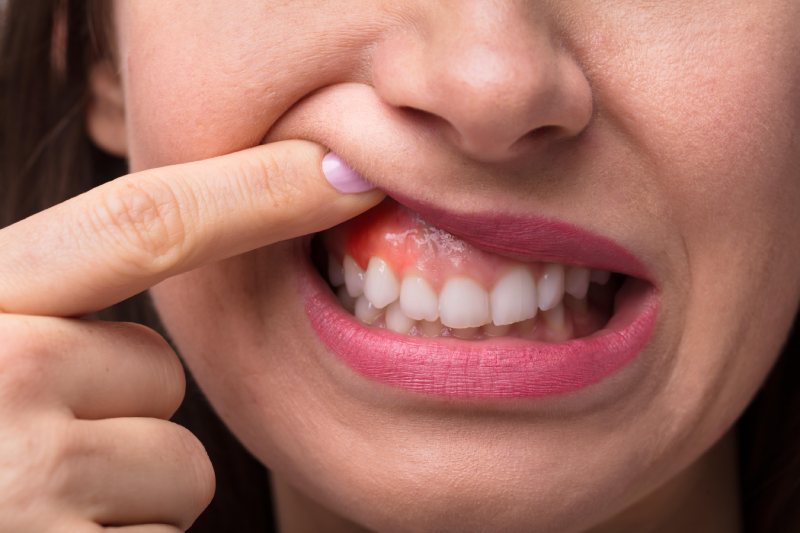
The most important factor causing gum diseases is the formation of bacterial plaque. In addition, consumption of alcohol, cigarettes and other tobacco products, side effects of certain medications, malnutrition and stress can cause tooth and gum diseases. Eliminating these causes is the first step to be taken to prevent tooth and gum diseases.
Smoking: In addition to all the known harms to the human body, smoking is an extremely harmful habit for oral and dental health. Smoking triggers oral and dental diseases, in other words periodontal diseases. Due to the heat of the cigarette, inflammation in the mouth can sometimes be concealed. In this case, the cigarette provides favorable conditions for the inflammation to hide. In such cases, the inflammation cannot be recognized unless it gives any symptoms.
Pregnancy and puberty: Periods such as pregnancy and puberty, when almost all hormones in the body change, also affect the mouth and teeth. Especially during these periods, a complete oral and dental care routine should be followed, teeth should be brushed and flossed regularly to prevent plaque build-up.
Diseases that affect the general health of the body: Diseases that target the body's defense system, such as diabetes, leukemia and AIDS, can impair the health of the gums. People with such health problems are very vulnerable to the development of infection. In addition, infection in the gums causes severe pain. It is also extremely difficult to control.
Various medications used: Some medications, such as anti-depressants and blood pressure medications, can adversely affect the oral tissues. In such cases, the gums can also suffer adverse effects.
Stress: Stress, which causes various damages in almost all parts of our body, can also have negative effects on oral and dental health. In addition, the process of fighting infection can become difficult due to stress.
Malnutrition: As a result of malnutrition, which weakens the immune system, the body can become vulnerable to infections and have difficulty fighting infections. Since oral and dental diseases are extremely serious infections, gingivitis can be exacerbated if malnutrition continues. In advanced stages, there may be undesirable situations such as tooth loss.
If gum diseases are not recognized or their treatment is neglected, very serious consequences can be faced. Gum diseases usually start with mild symptoms in the first stage, and more serious problems may arise over time. If gum diseases are not recognized or treated, the consequences that may be encountered can be listed as follows:
There is a strong relationship between gum disease and general health. Therefore, oral and dental health directly affects general health. According to research, gum disease can increase inflammation in the body, which in turn can increase the risk of heart disease. In addition, diabetes can facilitate the development of gum disease, and poor oral health can make it difficult to control diabetes. Gum disease is associated with an increased amount of bacteria in the mouth, which can lead to an increased risk of respiratory infections.
Teeth whitening, also called bleaching, is an aesthetic dentistry procedure applied to remove discolouration and staining that occur in the enamel and dentin layer of the tooth due to various reasons and to bleach the tooth colour. It is possible to use scaling and polishing to remove the discolouration of the natural colour of the teeth. However, not all stains and discolourations can be removed by these procedures. In such cases, teeth whitening comes into play as an effective solution.
Teeth whitening can be done using different methods. Which method will be preferred is determined depending on patient-specific needs, the desired result and other factors.
The method, also called "Office Bleaching", is applied by the dentist in a clinical environment. It provides fast and effective results. It is usually completed in 2 or 3 sessions of 15 minutes each. However, how many sessions the application will be completed may vary depending on the patient.
The first step of office type teeth whitening is scaling. Then, the desired tooth colour is determined by evaluating the patient's existing tooth colour. Teeth whitening gels with high whitening effect are used in the application, and a protective barrier is applied to the gums before the application to prevent damage to the soft tissues in the mouth.
Teeth whitening gel is applied to the teeth, laser or different light sources are used to activate it. After waiting for a certain period of time, it is checked how much whitening has occurred on the teeth. If the result obtained is not sufficient, the sessions are continued.
"Home Bleaching", i.e. home-type teeth whitening method, is planned by the dentist specifically for the patient. However, it is applied by the patient at home. The patient's upper and lower jaw measurements are taken and teeth whitening trays are prepared. The teeth whitening gel and teeth whitening trays that will provide the most effective result are given to the patient and how the application will be done is explained.
In order for the home teeth whitening treatment to be successful, the patient should apply the treatment determined by the dentist regularly and completely. Care should be taken about the application time and the dose of tooth whitening gel to be used.
In home-type teeth whitening treatment, the patient puts the teeth whitening gel given by the dentist into the teeth whitening moulds and attaches the moulds to the teeth. Since it is more practical, it is generally preferred to wear teeth whitening moulds at night. In order to achieve faster results, care should be taken not to use more than the recommended dose of tooth whitening gel.
The combined application of office type and home type teeth whitening methods is called combined teeth whitening. In order to reinforce the results obtained by applying the office type teeth whitening method and to ensure that these results last longer, it may be preferred to support the process with the home type teeth whitening method. Generally, the application of the combined teeth whitening method may be considered in patients with severe discolouration problems.
One of the factors that cause tooth discolouration is the death of the living tissue inside the tooth as a result of trauma or root canal treatment. When discolouration occurs in a single tooth, a single tooth whitening procedure is applied.
Within the scope of the single tooth whitening method, which is mostly preferred for teeth that have undergone root canal treatment and therefore discoloured, the filling inside the tooth is removed. Tooth whitening gel is placed in the opened cavity. The tooth is closed with a temporary filling. This process is continued until the desired whitening is achieved in tooth colour.
The permanence period of the results obtained with single tooth whitening treatment may vary depending on the frequency of consumption of foods and beverages that may cause discolouration on the teeth, smoking and various other factors. If deemed necessary, it may be possible to support the single teeth whitening method with 1 or 2 sessions performed in periods of 4 to 6 months. Thus, the permanence of the results obtained can be increased.

Teeth whitening treatment offers the opportunity to have a whiter and more impressive smile.
The self-confidence of people with white and bright teeth increases. It is possible to adopt a more confident attitude in business and social life relationships.
Thanks to teeth whitening, discolouration and staining caused by various reasons, especially food and drinks that cause discolouration on the teeth, can be removed. Thus, a healthier and cleaner appearance can be achieved.
How long the results obtained from teeth whitening application will be permanent may vary individually. The benefit to be obtained from teeth whitening and the permanence of the results depend not only on the structural features of the teeth, but also on how much care the patient takes to oral and dental health after teeth whitening.
At the same time, there are some points to be considered in order for the results obtained from teeth whitening to last longer. The most important of these is to limit the consumption of tea, coffee, cherry juice, red wine, caramel, tomato paste and similar foods and beverages that may cause discolouration on the teeth. In addition, oral and dental care routine should be applied correctly. Teeth should be brushed regularly, dental floss should be made a part of the oral care routine and regular dentist examinations should not be disrupted.
Various factors such as some foods and beverages consumed frequently in daily life, chlorine in drinking water, disorders that occur in the process of tooth formation during childhood, the effects of some antibiotics exposed in the womb or during infancy can cause tooth discolouration and staining.
While some people's tooth colour is naturally more yellow, some people's teeth may change colour due to excessive consumption of foods and beverages that cause discolouration. Regular brushing of the teeth is often not enough to eliminate the staining problem. In such cases, tooth whitening can be preferred as a functional and effective solution when the desired result cannot be obtained with toothpastes and polishers with whitening effect.
Teeth discolouration is categorised as internal discolouration and external discolouration, and how the teeth whitening application will be performed is determined accordingly. Teeth whitening treatment can be applied with different techniques such as home teeth whitening, office teeth whitening, combined teeth whitening and single teeth whitening.
The whitening technique to be applied to remove tooth discolouration is determined by the dentist for the patient. By applying the determined method, the patient can have whiter teeth.
How many sessions and how long it takes to complete the office-type and home-type teeth whitening procedures may vary depending on the scope of the treatment to be applied and the level of discolouration in the patient's teeth. Office type teeth whitening is usually completed in 2 to 3 sessions.
Home-type teeth whitening is usually completed in a period of 2 to 3 weeks. It may be possible to complete the treatment in 10 to 15 days if the teeth whitening trays are used for 4 to 6 hours during the day and in 8 to 10 days if they are used during night sleep. However, since individual differences and needs come into play at this stage, the decision on how long home teeth whitening will take is made individually for the patient.
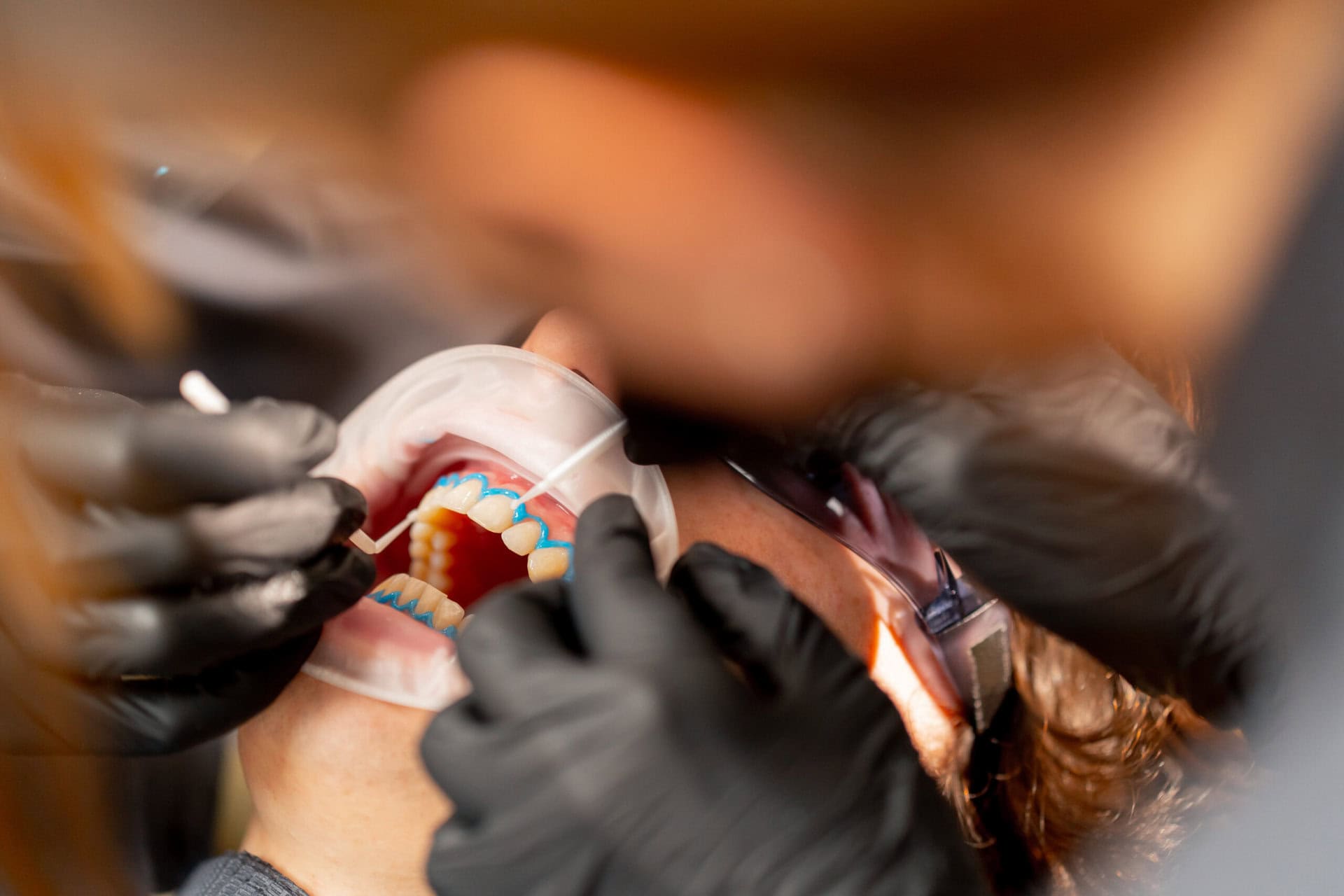
There is no risk of permanent damage to the teeth if teeth whitening is planned specifically for the patient by specialised and experienced dentists and applied with the right techniques. However, some temporary side effects may occur after teeth whitening.
After teeth whitening, dehydration, i.e. water loss, may occur in the teeth. Within 1 week following the teeth whitening application, the water content in the teeth is restored. With the elimination of water loss, the teeth gain a more natural and transparent appearance, and the opaque white appearance disappears.
Tooth sensitivity may be experienced for 2 to 3 days following teeth whitening treatment. In addition, soft tissue irritation may develop as a result of contact of the teeth whitening gel with tissues such as gums, lips and cheeks. Although it is possible for this situation to resolve spontaneously, a gel may be recommended by the dentist to speed up the process and increase patient comfort.
Teeth whitening is a practical and comfortable process that provides highly effective results. In addition, the results of teeth whitening treatment, which is more cost-effective than other aesthetic dentistry procedures, are obtained in a short time.
Teeth whitening prices are determined on a patient-specific basis according to which technique will be applied, how many sessions will be applied, the teeth whitening gel to be used, the price policy of the clinic and many other factors. In order to determine teeth whitening prices, the needs of the patient should be evaluated and the treatment to be applied should be planned.
Teeth whitening in Turkey has become an increasingly popular choice for those seeking a brighter smile. Here are some compelling reasons why:
MosDent Dental Hospital is a top choice for teeth whitening in Turkey, offering a comprehensive experience that combines expert care, modern technology, and a patient-focused approach:
Choosing MosDent for your teeth whitening procedure ensures you receive expert care, modern technology, and excellent service in a safe and comfortable environment.
Implant treatment is applied to complete the missing tooth or teeth in the mouth. Within the scope of the procedure, screw-shaped artificial tooth roots are placed in the jaw and it is generally preferred to use screws made of titanium. The procedure is completed by placing dental prostheses on the screws.
As part of implant treatment, one or more missing teeth are replaced with an artificial root and prosthesis. Unlike dentures, in other words, removable prostheses, which can be easily removed, dental implants are surgically placed in the jawbone.
The implant, which is usually made of titanium, looks like a screw. The bone grows over time around the implant, which is placed where the missing tooth roots are located in the jaw. Thus, the implant stays firmly in place. To fill the gap caused by the missing tooth, an artificial crown or tooth must be placed on the metal screw. Since the crowns are custom-made, they resemble the patient's other teeth in shape, color and size. In some cases, dental implants can be used to hold dentures or dental bridges in place.
One of the most popular dental procedures, dental implants are usually performed under local anesthesia. In the first stage of the procedure, a scan is performed and x-rays are taken. The dental implant is then placed into the jawbone through a surgical procedure. The bone inside the dental implant grows within a few months, allowing the implant to become stable. This provides a solid foundation for the new tooth or teeth. The patient's mouth impressions are taken to make the artificial tooth or teeth. Dental implant treatment is completed after screwing or bonding the artificial tooth or teeth to the foundation.
A dental implant is placed in the jawbone in about 10 to 25 minutes. However, in order for the treatment to continue, the implant must match and fuse with the jawbone and replace a real tooth root. This usually requires a period of time ranging from 3 to 6 months.
In order to reach the final stage of implant treatment, the implants placed in the jawbone must be fixed. In this way, the implant can carry the prostheses to be placed on it. How long it will take to complete the healing process in the patient with implant treatment may vary depending on many different factors, especially how strong the patient's bone structure is.
For implant treatment, the patient's gums must be healthy and the bone structure must be strong. Otherwise, bone powder is added to increase the thickness and height of the bone. Thanks to the procedure performed under local anesthesia, the bone powder placed with the patient's bone is replaced. With this process, which takes place over a period of approximately 6 months, it is ensured that the bone has sufficient strength for implant treatment.
Implant dental treatment is carried out by following different stages:
The patient undergoes a detailed examination. The gums, the relationship between the upper and lower jaw and the teeth are evaluated. The number, size and type of implants to be applied and the prostheses to be placed on the implants are determined. In addition to classical radiography, in complicated cases, three-dimensional tomography is used to meticulously plan the areas where the implants will be placed.
The operation phase is performed under local anesthesia. An incision is made through the gum and a slot is made in the bone to insert the implant. Special instruments are used to place the implant in this cylindrical slot. Depending on the number of implants to be applied, the duration of the procedure may vary.
After the implant is placed, a certain period of time is needed for it to integrate with the bone. This period is usually 2 to 2.5 months for the lower jaw and 3 to 4 months for the upper jaw. During this period, temporary prosthesis may be preferred to increase the comfort of the patient. However, it is important that patients do not place the chewing load directly on the implants during normal feeding processes.
Proper planning is very important for successful implant treatment. Again, the procedure should be performed by experienced and specialized dentists. Although the dental implant procedure is performed under local anesthesia, if the jawbone is not sufficient, it is necessary to add tissue called graft. In this case, it may be preferable to perform the procedure under general anesthesia or sedation in long operations or in extremely stressed patients.
Upon completion of the healing process and the complete filling of the implant surroundings with new bone, ensuring a strong adaptation to the bone, a prosthesis can be placed onto the implant. After taking measurements for the planned prosthesis, it may be preferable to fabricate the prosthesis as a single crown, bridge, partial, or full denture

Dental implants can be applied to individuals who have one or more missing teeth in their mouths due to decay, trauma, periodontal disease, or any other reason. Individuals may experience aesthetic and functional issues due to tooth loss in the oral cavity. Patients may feel uncomfortable with the appearance caused by tooth loss and may also encounter problems while eating and speaking. Additionally, preventing potential bone loss over time in the area of tooth loss can be possible through implant treatment, which has the ability to support the jawbone.
Dental implants are typically made from biologically compatible and durable materials. Implant materials can be defined as structures that can remain in the body for a long time, exhibit biocompatibility, and are usually placed through surgical procedures. The choice of materials for implants may vary depending on the areas where implants are used.
The most commonly used implant material is titanium. Titanium is a highly biocompatible metal that is lightweight and has a durable structure. Implants made from titanium or its alloys are designed to be resistant to oral fluids and withstand forces that may occur in the oral cavity.
Dental implant treatment includes the time from the initial examination of the patient to the placement of the implant, abutment, and crown. The completion time of dental implant treatment generally ranges from 3 to 9 months. However, like in all dental procedures, the duration of dental implant treatment can vary depending on various factors such as the individual's specific conditions, healing time, and the initial situation. If bone grafting or sinus lifting procedures are required for the patient, the completion time of dental implant treatment may be longer.
Dental implant treatment can be applied to individuals who are over 18 years old and have completed jaw and facial development. However, the eligibility for dental implant treatment is determined after specific evaluations for each patient.
Before applying dental implant treatment, the patient's jaw structure is examined, and a decision is made whether the patient is suitable for implant treatment. If the patient has diabetes, insulin levels should be controlled before treatment. If the patient is taking blood thinners, blood thinning medications should be stopped before the treatment under the supervision of a doctor. If the patient has bone resorption issues, dental implant treatment can be applied after completing the treatment processes.
Individuals with one or more missing teeth in the upper or lower jaw are suitable candidates for implant treatment. On the other hand, for the implantation of implants to stabilize in the jawbone, the bone structure in the planned treatment area must be sufficient, or bone grafting must be applied. In addition, the patient's oral tissue should be healthy, their general health condition should not be an obstacle to implant treatment, and they should not have diseases that could negatively affect bone healing. People who have received radiation therapy to the head and neck area or those whose bone development is not yet complete are not suitable for dental implant treatment.
Implant prices can vary depending on factors such as the number of implants to be applied for each patient, the quality of the materials used, which implant will be used, and many other different factors.
Over time, various factors such as tooth decay, tooth fractures, and the loss of durability and whiteness of teeth can compromise the health of the oral and dental structure. Aesthetic dentistry procedures come into play at this stage to help restore the teeth to their former appearance and health.
Before the advancements in aesthetic dentistry procedures, the only way to repair various damages or deficiencies in teeth was through dental prostheses. However, dental prosthetics could be considered a costly and exhausting treatment process. Dental veneer treatment, an effective and comfortable alternative offered by aesthetic dentistry, provides a much easier, faster, practical, and economical way to achieve healthy and aesthetically pleasing teeth.
In the context of dental veneer treatment, it is possible to cover the surface of teeth that have experienced excessive substance loss due to various reasons and have deviated from their aesthetic appearance with materials resembling the shape of teeth. One of the most commonly used materials in dental veneer procedures is zirconium. Zirconium, as a strong and aesthetically supportive material, enhances the success of dental veneer treatments for teeth that have been damaged or deviated from their aesthetic appearance. The process of covering teeth with zirconium is referred to as zirconium dental veneer.
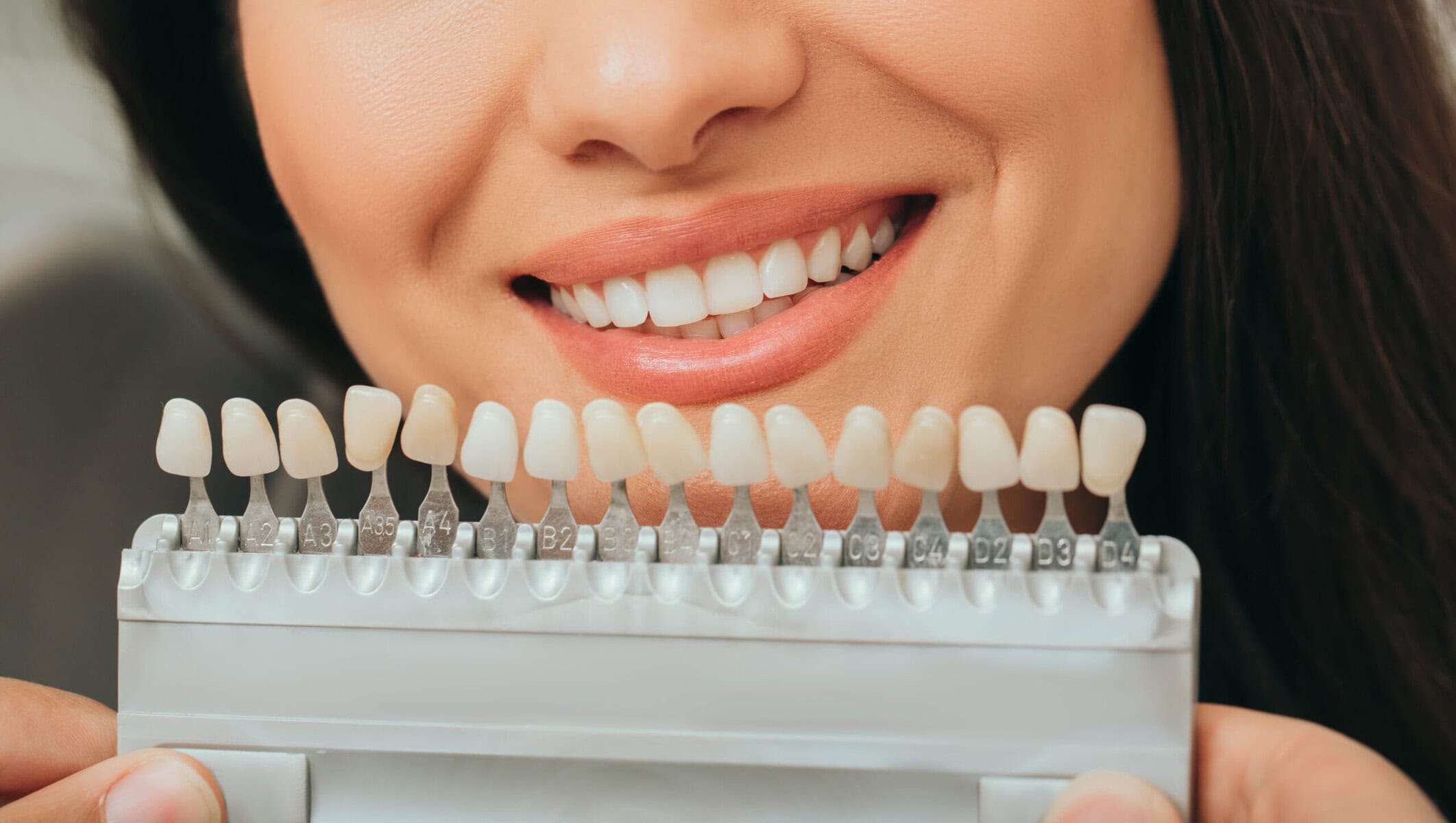
The decision to apply zirconium dental veneer treatment is made based on evaluations conducted for each individual patient. For zirconium dental veneer treatment to provide satisfactory results both in terms of health and aesthetics, the patient should not have any issues with their gum health. If a gum problem is identified, a treatment specifically targeting this issue should be applied first, and the healing process should be completed.
After evaluating the results of gum treatment from an aesthetic perspective, the smile line is examined. In cases where the smile line is high, if deemed necessary by the dentist, procedures are performed to adjust the gum levels, achieving a more aesthetic appearance.
Following the necessary adjustments to the teeth, measurements are taken using special measuring materials. Teeth are cut according to these measurements. Subsequently, the three-dimensional structure of the teeth is transferred to a digital environment using special scanners.
Using a system called CAD/CAM, zirconia blocks are prepared, forming the infrastructure for zirconium dental veneers. The zirconia blocks, which transfer the teeth to be prepared to three-dimensional structures, undergo the firing stage. Once the firing stage is completed, porcelain materials in suitable colors are added to the infrastructures, and zirconium crowns are completed. If no issues are identified during infrastructure trials, final adjustments are made. The zirconium veneers, with their polished and smooth surfaces, are then cemented and fixed onto the teeth.
Additionally, it is necessary to cut and reduce the size of the teeth during the zirconium dental veneer treatment. However, this process is performed under local anesthesia. Therefore, patients do not feel any pain or discomfort. Furthermore, since no pain or discomfort is felt during the processes of taking measurements and scanning the mouth, it can be stated that zirconium dental veneer treatment is extremely comfortable
In today's world, dental aesthetics play a crucial role not only in terms of health but also in beauty and aesthetics. Zirconium dental veneers offer a unique solution that perfectly meets these needs. Manufactured from a special ceramic material that mimics the natural appearance of teeth, zirconium dental veneers provide individuals with healthy, natural, and aesthetic-looking teeth. Color harmony and translucency features distinguish zirconium veneers from other alternatives.
Zirconium, known for its durability, ensures that individuals who choose zirconium veneers enjoy a safe and durable solution for daily chewing processes and other dental functions. This feature also makes zirconium veneers a long-lasting option.
Zirconium dental veneers offer a satisfying option both aesthetically and health-wise. Those who prefer this innovative solution can benefit from high standards in terms of natural appearance, durability, and biocompatibility.
Full zirconium crowns are used to cover the entire teeth and stand out with their high-performance level in meeting aesthetic expectations. They provide a natural appearance during smiles due to a translucency similar to natural teeth. Simultaneously, their durable structure ensures a long lifespan.
Zirconium porcelain dental veneers are excellent solutions that combine aesthetics and durability. The natural appearance of zirconium, combined with the aesthetic features of porcelain, results in homogeneous color and shape on the teeth.
In cases of tooth loss, zirconium bridges can become an aesthetic solution, completing missing teeth by attaching to neighboring teeth and providing a natural appearance.
Zirconium is also frequently used in implant-supported dental prostheses. These models, fixed onto implants, offer a feel and appearance similar to natural teeth. Being biocompatible provides a comfortable usage experience.
The lifespan of zirconium dental veneers generally ranges from 5 to 15 years. However, with the necessary attention to oral and dental health, and regular dental check-ups, this period can be extended up to 20 years.
There is no specific age limit for the use of zirconium dental veneers. In other words, zirconium dental veneers can be used in individuals of different age groups. However, the decision for treatment suitability is made based on factors such as general health condition, tooth structure, oral hygiene habits, and aesthetic expectations, considering each patient individually. Additionally, since zirconium dental veneer is a fixed dental procedure, it can be applied to individuals who have completed tooth and jaw growth and development. It is not recommended to perform the application until the age of 18 to 20, considering that the development period continues until this age, and gaps may occur due to jaw growth.
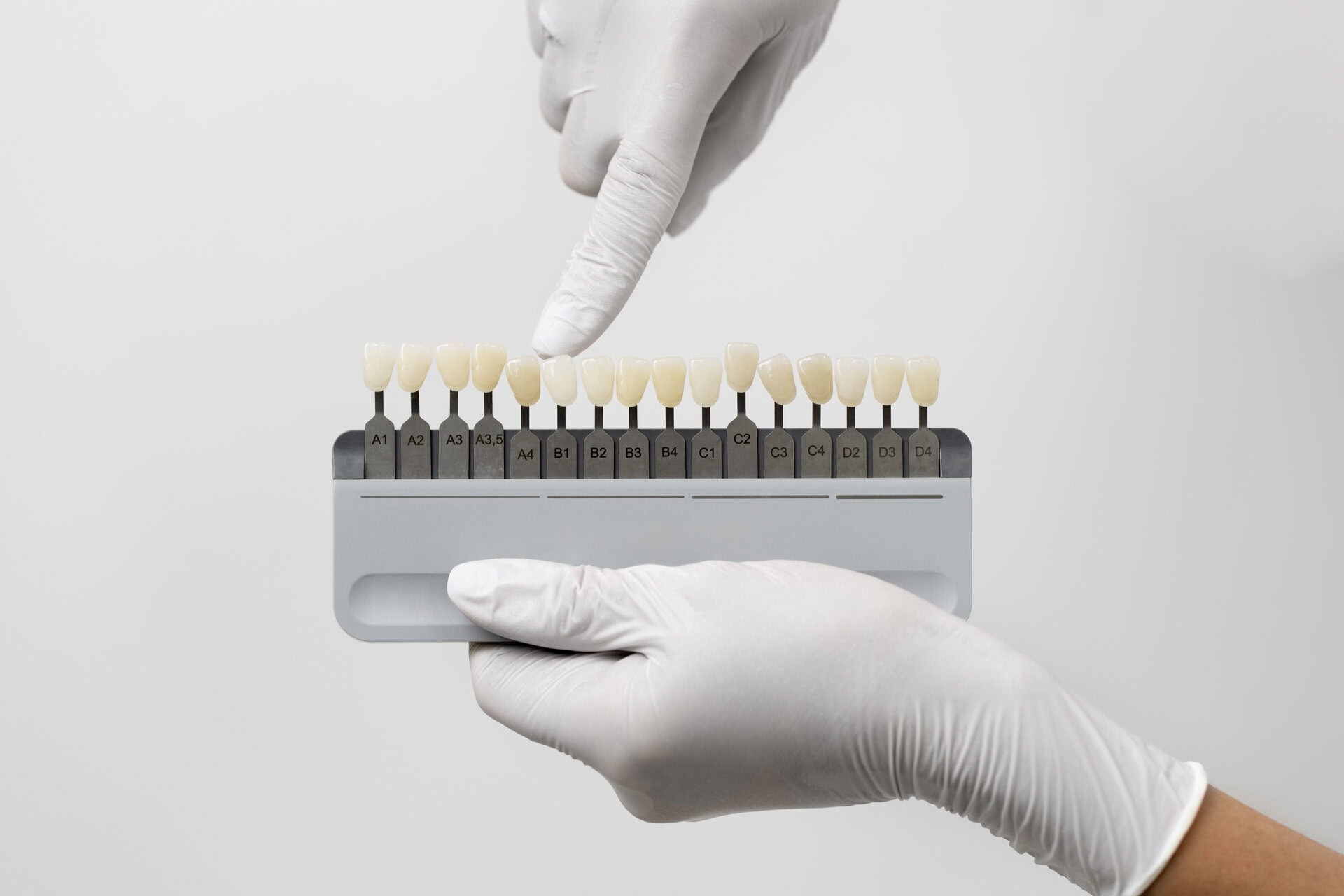
Zirconium dental veneer treatment is usually completed in 2 to 3 sessions. However, this duration can vary based on numerous factors. The current condition of the patient's teeth, specific requirements, expectations, and the scope of the treatment to be applied can affect how long the zirconium veneer treatment will take.
The prices for zirconium veneers, a dental procedure that provides highly healthy and aesthetic results, cannot be specified with a standard price since they are planned and applied individually. It would be more accurate to obtain a pricing after a dental examination. Various factors such as the number of teeth to be treated with zirconium, the quality of the materials to be used, whether the patient needs different dental or gum treatments, the pricing policy of the clinic where the application will be made, and many other different factors can be listed among the determinative factors affecting zirconium dental veneer prices.
Laminate veneer, also known as leaf tooth or laminate, is one of the most popular cosmetic dentistry procedures in recent years. In the scope of the laminate veneer procedure, the front surface of the teeth in the anterior group, which causes aesthetic dissatisfaction for the patient, is covered with thin porcelain. Laminate veneer treatment uses leaf porcelain to cover the front surface of the teeth, requiring minimal substance removal from the tooth.
The possibility of not removing too much substance from the tooth and the thickness of the plates attached to the tooth ranging from 0.3 to 0.5 mm are possible thanks to the laminate veneer treatment. Laminate veneer treatment can be used to address various issues such as discolored and stained teeth over time, as well as to repair fractured teeth, ultimately achieving smoother and aesthetically improved teeth.
Due to its success in providing natural whiteness to the patient's teeth, laminate veneer treatment is highly popular among women and men of different age groups. Additionally, due to its ability to support aesthetically satisfying results, laminate veneer is an essential element of smile design applications.
In the context of leaf tooth, laminate tooth coating, or laminate veneer treatment, porcelain leaf ceramics are attached to the front surface of the patient's teeth, which is the part of the teeth in contact with the lips and cheeks. Since the porcelain leaf ceramics used in laminate veneer treatment have a very thin structure, it is possible to eliminate the poor appearance on the front surface of the teeth and achieve aesthetically satisfying teeth. Laminate veneer application is an aesthetic dentistry procedure that helps individuals reconcile with their appearance and refresh their self-confidence with teeth that have a natural appearance.
Durable and resistant porcelain material is used in laminate veneer treatment. This ensures that substances that may cause discoloration of teeth, such as smoking, tea, and coffee, do not adversely affect tooth color. Since tooth tissue is removed in minimal amounts, the risk of developing hot-cold sensitivity in the teeth is minimized, and most patients do not experience tooth sensitivity.
Since there is no contact with the chewing surface of the teeth during treatment, the natural structure of the teeth is not disrupted, and natural tooth sensitivity does not disappear. This condition also shortens the time for the patient to get used to laminate tooth coatings. Porcelain is structurally a fragile material, but when bonded to tooth enamel, it gains high resistance to tensile and compressive forces. As a result, laminate veneer tooth coatings can be safely used without the risk of falling.
To achieve successful, natural, and comfortable results from laminate veneer treatment, the model of the teeth is prepared based on the measurements taken. The procedures to be performed are shown to the patient through this model, and approval is obtained.
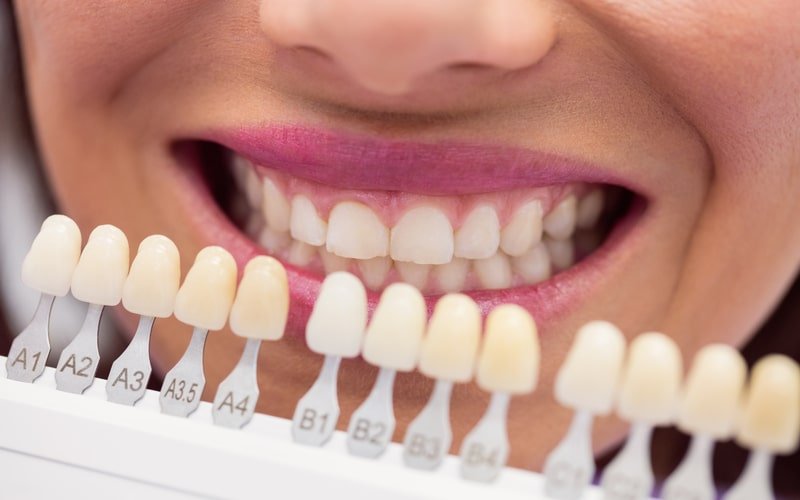
Laminate veneer treatment is commonly sought to address problems causing aesthetic concerns and lack of self-confidence, especially in the front teeth. Some of the main situations where laminate veneer treatment is applied include:
The suitability for laminate veneer treatment is decided individually for each patient after evaluations. Laminate veneer treatment is not applied to individuals who:

After laminate veneer treatment, paying attention to certain points ensures the comfortable and safe use of laminate coverings for an extended period. Avoiding the consumption of hard-shelled foods is crucial. Elastic and flexible foods should be sliced instead of bitten and torn.
Individuals with nighttime teeth grinding issues should use a nightguard. Regular brushing of laminate veneers, incorporating dental floss into oral care routines, and not using abrasive toothpaste are important. Routine dental check-ups should not be neglected to ensure that there is no deterioration on the surface of laminate veneer coverings.
During the initial step of laminate veneer treatment, the patient undergoes a detailed examination. This allows for the identification of the patient's needs and assessment of expectations. After determining the suitability of the patient for laminate veneer treatment, an individualized treatment plan is developed.
The front surface of the teeth to be treated with laminate veneer is shaped to prepare for the covering process. Since the procedure is performed under local anesthesia, the patient does not experience pain or discomfort. Following local anesthesia, a small section on the front of the teeth is prepared using a cutting instrument. This section should be compatible with the leaf coverings. An impression is taken using pressure, and this mold is used when preparing porcelain leaves.
In some cases, temporary laminates or temporary fillings may be applied to increase the patient's comfort. Laminate leaf teeth are applied to the prepared teeth and the laminate veneer treatment is completed.
The duration of completion for laminate veneer treatment can vary for each patient depending on the scope of the procedure. If there is no need for gum treatment or other aesthetic interventions before laminate veneer treatment, the treatment is generally completed within 2 to 3 sessions, equivalent to approximately 1 month. However, this duration can be extended if there are requirements for correcting the patient's teeth and applying different treatments.
Laminate veneer is a dentistry procedure that is planned and applied individually for each patient. Therefore, laminate veneer prices are not standard and can vary depending on the scope of the procedure planned for the patient. The prices for laminate veneers can differ based on the evaluation made for each patient after the specific treatment plan is determined.
Additionally, factors such as the experience of the dentist performing the treatment, the price policy of the clinic where the application will be made, the quality of the materials used in laminate veneer treatment, and whether different tooth and/or gum treatments will be applied to the patient are taken into consideration when determining laminate veneer prices.
Due to the need for special materials in laminate veneer treatment, the complexity of laboratory processes, and the requirement for specialized knowledge and expertise in taking the patient's tooth measurements, preparing laminate veneer coverings, and applying the procedure, the cost of laminate veneer treatment may be slightly higher compared to alternative treatments.
Emax - empress porcelains are among the most aesthetically advanced veneers with their structure made of reinforced porcelain in their infrastructure or completely made of reinforced porcelain as a block. Emax dental veneers, in other words empress dental veneers, are basically based on lithium disilicate glass and have the feature of being a completely ceramic dental coating system consisting of elements such as lithium dioxide, quartz, alumina, potassium oxide.
Today, special ceramics are used to ensure that individuals have realistic and natural-looking smiles. Unlike other dental restoratives, emax tooth is a ceramic material that provides a durable and aesthetic appearance at the same time. Dental restorations made entirely of ceramic do not contain metal. Therefore, the light shines inside the tooth as it does in natural teeth. Generally applied to the front incisors, emax tooth is not preferred for the teeth in the back of the mouth because it does not have sufficient durability.
In addition to being one of the most preferred crowns by dentists, emax teeth are also popular among patients. Long-lasting and durable, emax tooth offers an aesthetically pleasing appearance that resembles natural teeth. Made of lithium disilicate ceramic ingot, known for its durability, emax tooth provides the look and feel of a real tooth.
Strikingly similar to natural teeth, it is one of the most vibrant materials that can be used for a crown, and it is also possible to benefit from its translucency and ability to color to match all shades of teeth. The shine of natural teeth can also be achieved with emax teeth, as they are made entirely of ceramic and contain no metals. Being resistant to chipping, emax teeth are less likely to chip and crack than crowns made of porcelain and zirconium materials.
The lifespan of Emax dental crowns usually varies between 10 and 20 years, but this period may vary depending on how much attention the patient pays to the oral and dental care routine. In order to prolong the lifespan of Emax dental veneers, the patient should pay attention to their oral and dental care routine as well as regular dental check-ups. Therefore, a standardized lifetime of emax dental veneers cannot be mentioned for each patient.
Thanks to Emax dental coating treatment, the patient's teeth can gain a more pleasant and aesthetic appearance. On the other hand, if the patient's teeth are broken, destroyed or discolored due to many different reasons, it may be possible to benefit from emax dental veneers treatment. The success of emax dental veneers treatment, just like other dentistry procedures, depends on the fact that the planning is made in accordance with the needs of the patient and the treatment is applied by an expert and experienced dentist.
Made of high quality, fully porcelain material, empress teeth offer aesthetically satisfying results by imitating the appearance of natural teeth. The durability of the porcelain is increased by reinforcing the ceramic piece with glass ceramic without using any metal material. These porcelains are used in empress dental veneers treatment.
Empress dental veneers are one of the most widely used aesthetic dentistry procedures today. Empress dental veneers provide extremely successful results, especially in patients who have problems with their front teeth. It may also be preferable to use empress dental veneers on molars, where less force is applied compared to the front teeth.

Emax & empress dental veneers are specially reinforced porcelains that do not contain metal infrastructure. Thanks to Emax & empress dental veneers, it is possible to achieve a perfect aesthetic and gum harmony. The veneers have high herpes permeability and resemble the appearance of natural teeth, so they can be used to meet high aesthetic expectations and in the front areas of the mouth. Emax & empress porcelain dental veneers are generally used in the front areas of the mouth, and zirconium dental veneer treatment may be preferred in the back areas where high resistance and aesthetics are required.
In order to understand the need for Emax empress dental veneers treatment, it is first determined which part of the patient's mouth will be corrected. Patients who have complaints about their front teeth and need correction of their front teeth are generally considered suitable candidates for emax empress dental veneers treatment.
In cases where aesthetic veneer treatment will be applied on a single tooth, emax empress dental veneer treatment may be preferred. However, if the patient also has a lack of teeth, emax empress dental veneer treatment may not be the right option.
In patients who are decided to be suitable for Emax empress dental treatment, the teeth are first photographed and impressions of the teeth are taken. In order to prepare the teeth for emax empress dental veneers, an abrasion process must be performed on the teeth. Teeth are adjusted to be suitable for veneers and impressions are taken again. Emax empress dental veneers are prepared in the laboratory according to the measurements taken from the patient and adhered to the teeth with medical adhesive. With the application of these steps, emax empress dental veneer treatment is completed.

Emax empress tooth coating treatment;
After Emax empress dental veneers treatment, patients can have an aesthetic smile and a smooth and healthy tooth alignment. Emax empress dental veneers give the most natural and effective results on the front incisors where aesthetic concerns are at the forefront.
On the other hand, emax empress dental veneer treatment;
As with all dental procedures, the prices for Emax and Empress dental crowns can vary based on several different factors. Fundamental factors that determine the cost include the current oral and dental health of the patient and the number of teeth to undergo Emax and Empress dental crown treatment.
Emax and Empress dental crown treatment can only be applied to patients with healthy teeth and gums. If any decay or issues requiring other dental treatments are identified in the tooth or teeth planned for the Emax and Empress dental crown treatment, the dentist will first address and treat the dental decay or other problems. Therefore, whether another dental treatment is required for the patient undergoing Emax and Empress dental crown treatment is one of the decisive factors influencing the prices.
In addition to these factors, the experience of the dentist performing the Emax and Empress dental crown treatment, the pricing policy of the clinic where the treatment is conducted, and the quality of materials and equipment used during the treatment also directly affect the prices of Emax and Empress dental crowns
